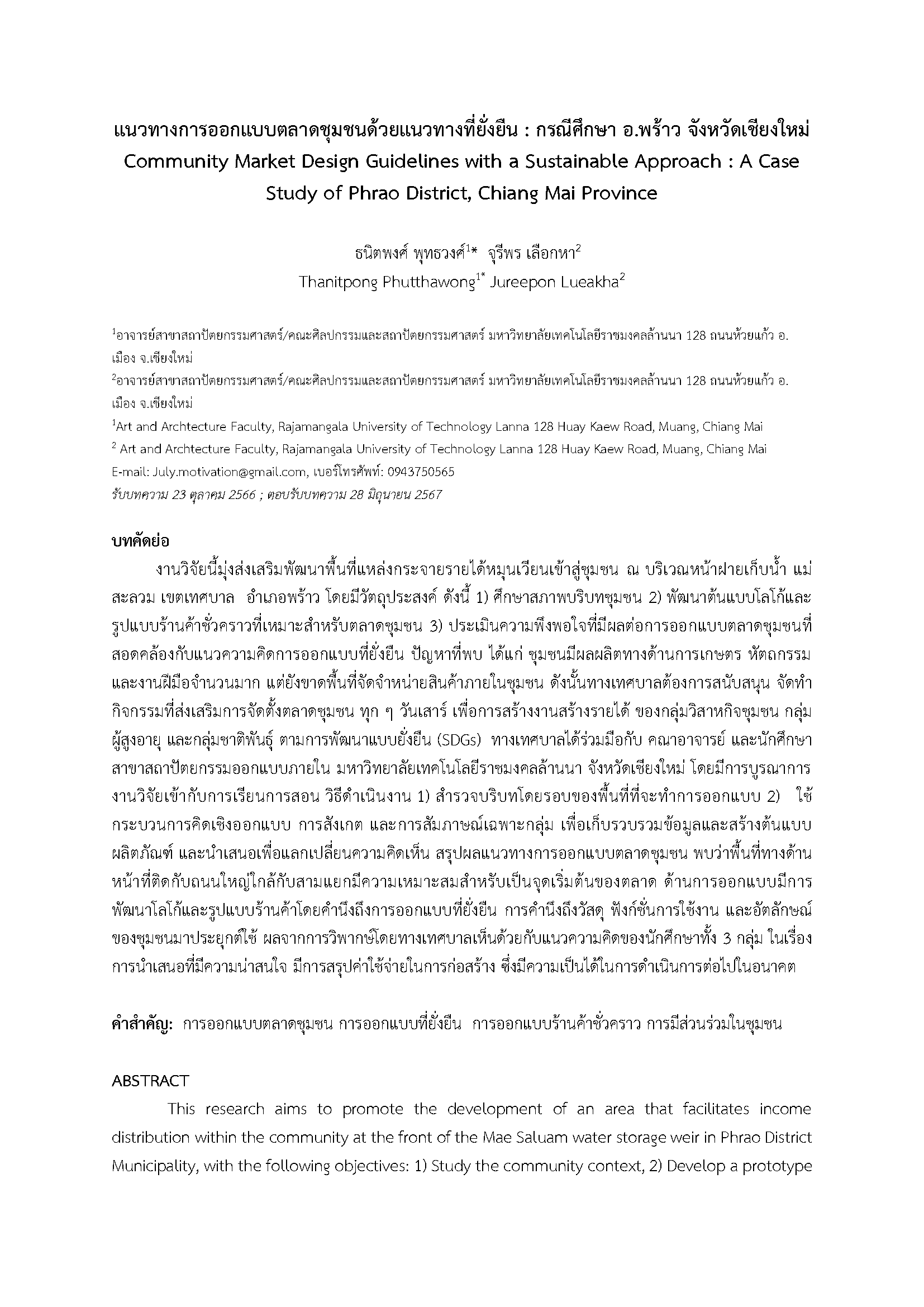Community Market Design Guidelines with a Sustainable Approach : A Case Study of Phrao District, Chiang Mai Province
Main Article Content
Abstract
This research aims to promote the development of an area that facilitates income distribution within the community at the front of the Mae Saluam water storage weir in Phrao District Municipality, with the following objectives: 1) Study the community context, 2) Develop a prototype logo and temporary store design suitable for the community market, and 3) Assess satisfaction regarding the community market design in line with sustainable design concepts. Problems encountered include a large amount of agricultural products and handicrafts but a lack of space to distribute these products within the community. Therefore, the municipality aims to support activities that promote the establishment of a community market every Saturday to create jobs and income for community enterprise groups, the elderly, and ethnic groups in accordance with Sustainable Development Goals (SDGs). The municipality has collaborated with professors and students from the Faculty of Architecture and Interior Design at Rajamangala University of Technology Lanna, Chiang Mai Province, by integrating research with teaching and learning. Methods: Explore the surrounding context of the area to be designed. Use design thinking processes, observation, and focus group interviews to collect data and create product prototypes, then present them to exchange opinions. It was found that the area next to the main road near the intersection is suitable as the starting point for the market. On the design side, logos and store layouts were developed with sustainable design in mind, considering materials, functionality, and the community's identity. The municipality agreed with the ideas from all three student groups regarding the presentations. Construction costs were summarized, indicating the feasibility of continuing the project in the future.
Article Details
This article is published under a Creative Commons Attribution-NonCommercial-NoDerivatives 4.0 International License (CC BY-NC-ND 4.0), which allows others to share the article with proper attribution to the authors and prohibits commercial use or modification. For any other reuse or republication, permission from the journal and the authors is required.
References
กานต์ คำแก้ว, วิฑูรย์ เหลียวรุ่งเรือง และ ลลิตา จรัสกร (2555). การใช้วัสดุในท้องถิ่นเพื่อการออกแบบ สถาปัตยกรรม ในพื้นที่ห่างไกล. Local Material Utilization for Architectural Design in Remote Areas.
กิตติพงษ์ ล้ออุทัย. 2554. แนวคิดในการอนุรักษ์ และ
พัฒนาชุมชนอย่างยั่งยืน กรณีศึกษา: ชุมชนตลาด ล่างใน เขตเมืองเก่าลพบุรี (Doctoral dissertation, จุฬาลงกรณ์มหาวิทยาลัย).
พระครูใบฎีกา วิชาญวิสุทโธ และภักดี โพธิ์สิงห์. 2565. “การขับเคลื่อนตลาดนัดชุมชนสู่การพัฒนาเศรษฐกิจฐานราก.” วารสารมหาจุฬาคชสาร. 13, 2: 1-14
สวลักษณ์ เชื้อสุวรรณ์. (2024). การศึกษา อัตลักษณ์ทางสถาปัตยกรรมเพื่อเสนอแนวทางการ ออกแบบสภาพแวดล้อมตลาดและร้านค้าชุมชน ต้นแบบสำหรับการพัฒนาเศรษฐกิจท้องถิ่นบ้านในวง ใต้อำเภอละอุ่น จังหวัดระนอง. วารสาร ตำหนัก, 1(2), 49-64.
สำนักงานสถิติจังหวัดเชียงใหม่. 2565. รายงานสถิติจังหวัดเชียงใหม่. Chaing Mai Provincial Statistical Report. เข้าถึงได้จาก: https://chiangmai.nso.go.th/images/s-101 .pdf. 30 มิถุนายน 2567.
สำนักงานสภาเกษตรกร จังหวัดเชียงใหม่, 2564. อำเภอพร้าว จังหวัดเชียงใหม่. เข้าถึงได้จาก:
จาก: https://www.nfccmi.or.th/assets/
uploads/pages_img/57b40-จังหวัดเชียงใหม่.pdf. 28 มิถุนายน 2567.
Daniel. 2007. Sustainable Design: Ecology, Architecture, and Planning. Canada: John Wiley & Sons.
Erfaneh and Mohammadali. 2020. Sustainable
Street Furniture. Periodica Polytechnica Architecture. 51(1), 65-74
Ryan. 2018. Sustainable kiosk development utilising culturally adaptive user interfaces and a novel interaction method. Doctoral dissertation. University of West London.


